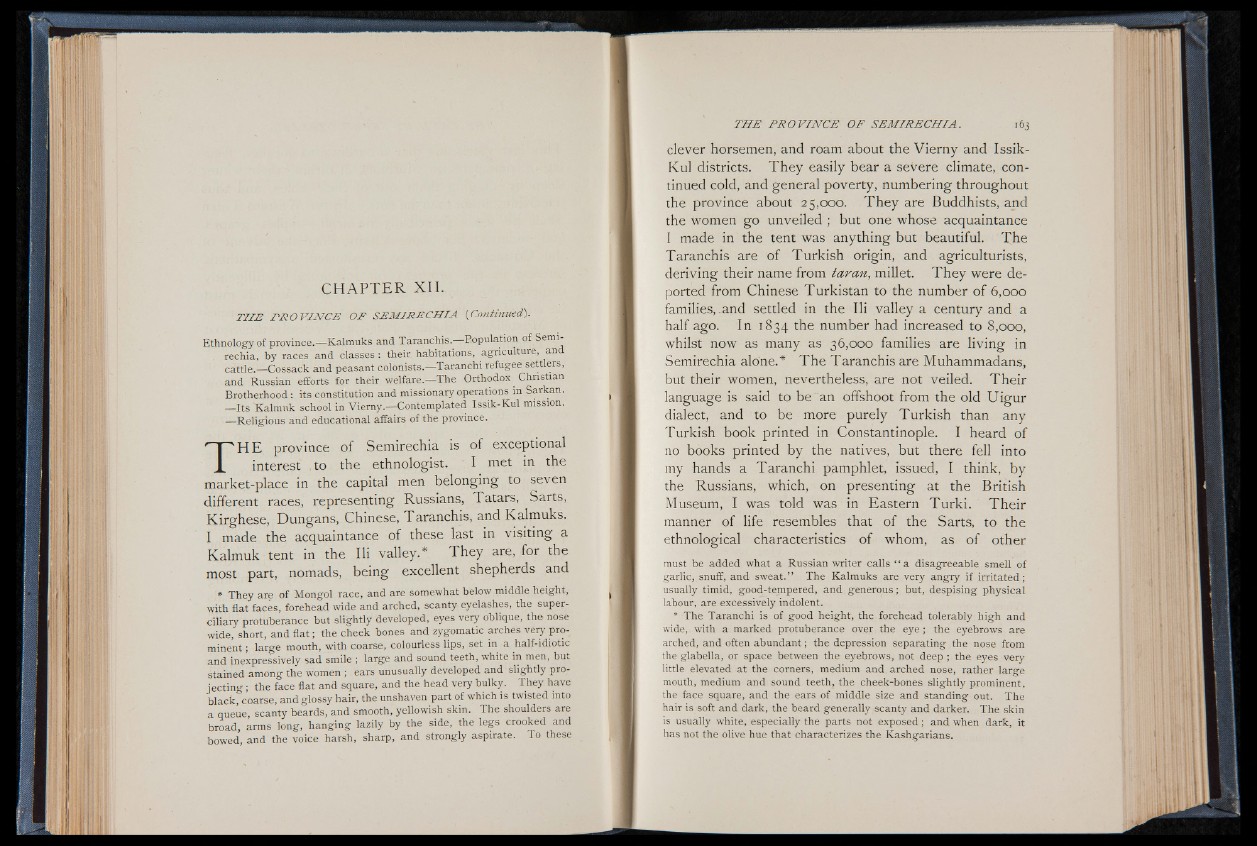
C H A P T E R X I I .
TH E P R O V IN C E OF SEM1R E CH IA (Continued).
Ethnology of province.— Kalmuks and Taranchis. Population of Semi
rechia, by races and classes : their habitations, agriculture, an
cattle.— Cossack and peasant colonists.— Taranchi refugee settlers,
and Russian efforts for their welfare.— The Orthodox Christian
Brotherhood: its constitution and missionary operations in Sarkan.
— Its Kalmuk school in Viem y.— Contemplated Issik-Kul mission.
— Religious and educational affairs of the province.
TH E province of Semirechia is of exceptional
interest to the ethnologist. ' I rnet in the
market-place in the capital men belonging to seven
different races, representing Russians, Tatars, Sarts,
Kirghese, Dungans, Chinese, Taranchis, and Kalmuks.
I made the acquaintance of these last in visiting a
Kalmuk tent in the Ili valley.* They are, for the
most part, nomads, being excellent shepherds and
* They are of Mongol race, and are somewhat below middle height,
with flat faces, forehead wide and arched, scanty eyelashes, the superciliary
protuberance but slightly developed, eyes very oblique, the nose
wide, short, and f la t ; the cheek bones and zygomatic arches very prominent
; large mouth, with coarse, colourless lips, set in a half-idiotic
and inexpressively sad smile ; large and sound teeth, white in men, but
stained among the women ; ears unusually developed and slightly proje
c tin g ; the face flat and square, and the head very bulky. They have
black, coarse, and glossy hair, the unshaven part of which is twisted into
a queue, scanty beards, and smooth, yellowish skin. The shoulders are
broad, arms long, hanging lazily by the side, the legs crooked and
bowed, and the voice harsh, sharp, and strongly aspirate. To these
clever horsemen, and roam about the Vierny and Issik-
Kul districts. They easily bear a severe climate, continued
cold, and general poverty, numbering throughout
the province about 25,000. They are Buddhists, and
the women go unveiled ; but one whose acquaintance
I made in the tent was anything but beautiful. The
Taranchis are of Turkish origin, and agriculturists,
deriving their name from taran, millet. They were deported
from Chinese Turkistan to the number of 6,000
families, .and settled in the Ili valley a century and a
half ago. In 1834 the number had increased to 8,000,
whilst now as many as 36,000 families are living in
Semirechia alone.* The Taranchis are Muhammadans,
but their women, nevertheless, are not veiled. Their
language is said to be an offshoot from the old Uigur
dialect, and to be more purely Turkish than any
Turkish book printed in Constantinople. I heard of
no books printed by the natives, but there fell into
my hands a Taranchi pamphlet, issued, I think, by
the Russians, which, on presenting at the British
Museum, I was told was in Eastern Turki. Their
manner of life resembles that of the Sarts, to the
ethnological characteristics of whom, as of other
must be added what a Russian writer calls “ a disagreeable smell of
garlic, snuff, and sweat.” The Kalmuks are very angry if irritated;
usually timid, good-tempered, and generous; but, despising physical
labour, are excessively indolent.
* The Taranchi is of good height, the forehead tolerably high and
wide, with a marked protuberance over the eye ; the eyebrows are
arched, and often abundant; the depression separating the nose from
the glabella, or space between the eyebrows, not deep ; the eyes very
little elevated at the corners, medium and arched nose, rather large
mouth, medium and sound teeth, the cheek-bones slightly prominent,
the face square, and the ears of middle size and standing out. The
hair is soft and dark, the beard generally scanty and darker. The skin
is usually white, especially the parts not exposed; and when dark, it
has not the olive hue that characterizes the Kashsrarians.